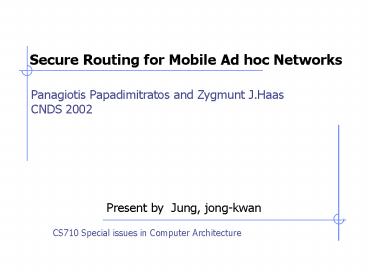Secure Routing for Mobile Ad hoc Networks PowerPoint PPT Presentation
1 / 21
Title: Secure Routing for Mobile Ad hoc Networks
1
Secure Routing for Mobile Ad hoc Networks
Panagiotis Papadimitratos and Zygmunt J.HaasCNDS
2002
- Present by Jung, jong-kwan
CS710 Special issues in Computer Architecture
2
Contents
- Introduction
- Related work
- Proposed Scheme
- Protocol Description
- Protocol Correctness Proof
- Conclusions
3
Introduction
- Feature of MANET
- Absence of a fixed infrastructure
- - Impede the practice of establishing a line of
defense - Roaming node
- - difficult to have a picture of the ad hoc
network - membership
- No guarantee that a path between two nodes would
- be free of malicious nodes
- Technique in the MANET context of route
- discovery based on broadcasting query packets
4
Related Work
- Enforcing Service Availability in Mobile Ad Hoc
- Provide incentive to nodes
- Ad hoc On-Demand Distance Vector Routing
- An extension of the AODV
- Secure Message Transmission in Mobile Ad Hoc
Networks - Determines a set of diverse paths connecting the
source and the destination nodes
5
Proposed Scheme(1/3)
- Basic assumption
- Focus on bi-directional communication between a
pair of nodes - Security Association (SA)
- Existence of shared key Ks,t
- An attack mounted by two colluding nodes during a
single route discovery
6
Proposed Scheme(2/3)
- Overview
- Provide approach to the secure route discovery
operation - Source node S initiates the route discovery
- Intermediate nodes relay route request
- Destination T constructs the route replies
7
Proposed Scheme(3/3)
- Example Topology
- Qs,tn1,n2,,nk SRP Header for a query
searching for T - Rs,t n1,n2,,nk
8
Proposed Scheme(1/4)
- Scenarios of security attacks by two malicious
nodes - Scenario 1
- M1 receives Qs,tS
- M1 generates Rs,t S,M1,T
- T disallows any intermediate node to provide a
reply - M1 does not posses Ks,t
9
Proposed Scheme(2/4)
- Scenario 2
- M1 discards request packets arriving from its
neighbors - Scenario 3
- M1 receives Rs,t S, 1, M1, 5, 4, T and relays
Rs,t S, 1, M1, Y, T - Integrity protection provided by the MAC
10
Proposed Scheme(3/4)
- Scenario 4
- M2 receives Qs,t S, 2, 3 and relays Qs,t
S, X, 3,M2 - Scenario 5
- M1 attempts to forward Qs,t S, M IP
spoofing - Mask its identity will be temporary
11
Proposed Scheme(4/4)
- Scenario 6
- M1 attempts to return a number of replies with a
different spoofed IP - Relay more than one route requests, placing a
different IP address in each of them
12
Protocol Description (1/5 )
- SRP can be incorporated in the underlying basic
protocol
01234567890123456789012345678901
IP Header
Basic Routing Protocol Packet
SRP Header
13
Protocol Description (2/5 )
- Route Request
- S maintains a Query Sequence number Qseq
- S generates a 32-bit random Query Identifiers Qid
- Both Qid and Qseq are placed in the SRP header
01234567890123456789012345678901
Reserved
Type
Query Identifier
Query Sequence Number
SRP MAC
14
Protocol Description (3/5 )
- Query Handling/ Propagation
- Intermediate nodes parse the received Route
Request - If an SRP header is present
- Extract the Qid, the source and destination
address - Queries with Qid match one of the Query table
entries are discarded - Intermediate nodes measure the frequency of
queries received from their neighbors - Benign node maintains a priority of ranking of
its neighbors - The highest priority nodes generating request
with the lowest rate
15
Protocol Description (4/5 )
- Route Reply
- T validates the received route request packet
- If Qseq lt Smax, the request is discarded
- Otherwise. T calculates the keyed hash of the
request field - T generates a number of replies
- Source-route a reply with an empty payload
- Route Reply Validation
- S check the source and destination address, Qid,
Qseq - S calculates the MAC
16
Protocol Description (5/5 )
- Intermediate Node Replies
- Intermediate Node Reply Token(INRT)
01234567890123456789012345678901
SRP Header
IN Reply Token
17
Protocol Correctness Proof(1/4)
- Idealized SRP
- H Message Authentication Code function
- Rst route reply
(1) Qs,t,H(Qs,t,Ks,t)
S
T
(2) Rs,t,route,H(Rs,t,route,Ks,t)
18
Protocol Correctness Proof(2/4)
- Initial assumption
- For message(1), we have
(i)
(ii)
(iii)
(iv)
19
Protocol Correctness Proof(3/4)
- From (i), (iii), (iv), (vi), we get
(v)
(vi)
(vii)
20
Protocol Correctness Proof(4/4)
- And finally
(viii)
(ix)
(x)
21
Conclusions
- Proposed an efficient secure routing protocol
- Guarantees the discovery of correct connectivity
information over an unknown network - The resultant protocol is capable of operating
without the existence of an on-line certification
authority

